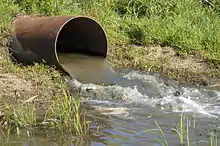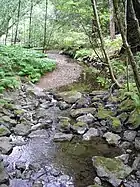Effluent
Effluent is an outflowing of water or gas to a natural body of water, from a structure such as a sewage treatment plant, sewer pipe, industrial wastewater treatment plant or industrial outfall. Effluent, in engineering, is the stream exiting a chemical reactor.[1]

Definition
Effluent is defined by the United States Environmental Protection Agency as "wastewater - treated or untreated - that flows out of a treatment plant, sewer, or industrial outfall. Generally refers to wastes discharged into surface waters".[2] The Compact Oxford English Dictionary defines effluent as "liquid waste or sewage discharged into a river or the sea".[3]
Description
Effluent in the artificial sense is in general considered to be water pollution, such as the outflow from a sewage treatment facility or the industrial wastewater discharge from industrial facilities. An effluent sump pump, for instance, pumps waste from toilets installed below a main sewage line. In the context of waste water treatment plants, effluent that has been treated is sometimes called secondary effluent, or treated effluent. This cleaner effluent is then used to feed the bacteria in biofilters.[4]
In the context of a thermal power station and other industrial facilities, the output of the cooling system may be referred to as the effluent cooling water, which is noticeably warmer than the environment and is called thermal pollution.[5]: 375
Pollution control regulation
In the United States, the Clean Water Act requires all effluent discharges to surface waters to be regulated with permits under the National Pollutant Discharge Elimination System (NPDES). The permits require discharging facilities to use treatment technologies or best management practices to mitigate the effects of discharges on the receiving waters.[6]
See also
- Effluent guidelines (U.S. wastewater regulations)
- Effluent limitation
- Wastewater
References
- Fogler, H. Scott (2006). Elements of Chemical Reaction Engineering. Hoboken, NJ: Prentice Hall. p. 43. ISBN 9780131278394.
- "Terms of Environment". Washington, D.C.: United States Environmental Protection Agency (EPA). February 1993. p. 10. EPA 175=B=93-001.
- "AskOxford: effluent". Ask Oxford.com. Oxford University Press. 2010. Retrieved 2010-06-09.
- George Tchobanoglous, Franklin L. Burton, H. David Stensel, Metcalf & Eddy (2003). Wastewater engineering: Treatment and reuse (4th ed.). Boston: McGraw-Hill. ISBN 0-07-041878-0. OCLC 48053912.
{{cite book}}: CS1 maint: uses authors parameter (link) - Laws, Edward A. (2017). Aquatic Pollution: An Introductory Text (4th ed.). Hoboken, NJ: John Wiley & Sons. ISBN 9781119304500.
- "NPDES Permit Limits". National Pollutant Discharge Elimination System. EPA. 2021-10-11.
